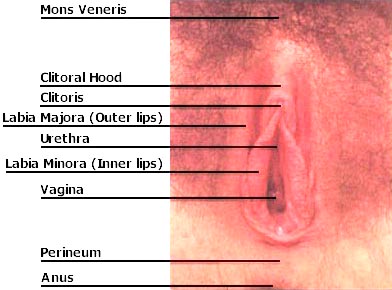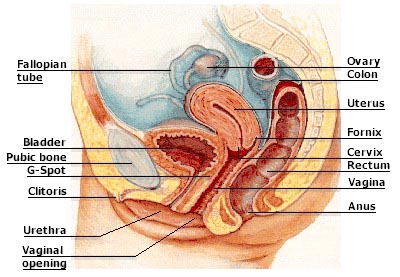Female Orgasm and Clitoris Erection Enhancement
 |
|||||
|
|
|||||
 | |||||
Adult Sex Ed.The BasicsFemale Anatomy Female Orgasm Female Ejaculation Sex Positions Advanced Cunnilingus Fellatio Masturbation Pregnancy |
Female Reproductive AnatomyThe female genital structure is perhaps the least fully understood aspect of human sexuality. In that light, we have put together this in-depth guide to the external and internal female genitalia, along with definitions and explanations of each feature. The guide to the external female genitalia should provide a smooth transition to the internal female genitalia below and help make understanding the location of the features much easier.

VulvaMons veneris:Latin for "hill of Venus" (Roman Goddess of love), this is the area of fatty tissue that covers the pubic bone below the abdomen but above the labia. The mons is sexually sensitive in some women and protects the pubic bone from the impact of sexual intercourse. This is the region that contains the familiar and typical "triangle" of pubic hair above the vulva. [top]Clitoral hood:This is the "hood" of flesh that partially or fully covers the unstimulated clitoris. It serves to protect the sensitive treasure beneath. [top]Labia Majora:The labia majora are the outer lips of the vulva, pads of fatty tissue that wrap around the vulva from top to bottom around the mons to the perineum. These labia are usually covered with pubic hair, and contain numerous sweat and oil glands, and it has been suggested that the scent from these are sexually arousing. During sexual arousal, inner lips become engorged with blood. [top]Labia Minora:The labia minora are the inner lips of the vulva, thin stretches of tissue directly inside of the labia majora that fold and protect the vagina, urethra, and clitoris. The appearance of labia minora can vary widely, from tiny lips that hide between the labia majora to large lips that protrude. The most common metaphor for the labia minora is that of a flower. Both the inner and outer labia are quite sensitive to touch and pressure, and they are highly elastic in some women. The labia minora are analogous to the male testicle sack, or scrotum, and they have the same sensitivity. [top]Urethra:The opening to the urethra is just below the clitoris. It is not related to sex or reproduction, but it's where urine is expelled from the body. The urethra is connected to the bladder. Because the urethra is so close to the anus, women should always wipe themselves from front to back to avoid infecting the vagina and urethra with bacteria. [top]Vagina:The vagina extends from the vaginal opening to the cervix, the opening to the uterus. The vagina serves as the receptacle for the penis during sexual intercourse, and as the birth canal through which the baby passes during labor. The average vaginal canal is three inches long, possibly four in women who have given birth. This may seem short in relation to the penis, but during sexual arousal the cervix will lift upwards and the fornix may extend upwards into the body as long as necessary to receive the penis. After intercourse, the contraction of the vagina will allow the cervix to rest inside the fornix, which in its relaxed state is a bowl-shaped fitting perfect for the pooling of semen. [top]Perineum:The perineum is the short stretch of skin starting at the bottom of the vulva and extending to the anus. The perineum in women often tears during birth to accommodate passage of the child, and this is apparently natural. Nevertheless, the perineum is highly sensitive and can be a source of pleasure during foreplay and intercourse for both men and women. [top]Anus:The anus is where solid waste exits the body. While not connected to reproduction, the anus is still very highly sensitive to touch and can be a source of great pleasure. [top]Internal female genitalia
Fallopian Tube:This is either of a pair of slender ducts through which ova pass from the ovaries to the uterus during the menstrual cycle. [top]G-Spot:In the illustration alongside, what is indicated as the g-spot in fact points to a region known as the Skenes glands, the purpose of which are unknown. Despite the surrounding controversy of its existence, one fact remains- there are many women who claim that pressure on this region of the vagina is extremely pleasurable. Usually, two fingers are used, and because the spot is deep within the tissue, some pressure may be needed. Also, because the Skenes glands are alongside the bladder, some women may found that the increased pressure makes them feel as if they need to urinate. [top]Ovaries:The ovaries perform two functions: the production of estrogen and progesterone, the female sex hormones, and the production of mature ova, or eggs. At birth, the ovaries contain nearly 400,000 ova, and those are all she will ever have. However, that is far more than she will need, since during an average lifespan she will go through about 500 menstrual cycles. After maturing, the single egg travels down the fallopian tube, a journey of three or four days-- this is the period during which a woman is fertile and pregnancy may occur. Eggs that are not fertilized are expelled during menstruation. [top]Uterus:The uterus, or womb, is the main female internal reproductive organ. The inner lining of the uterus is called the endometrium, which grows and changes during the menstrual cycle to prepare to receive a fertilized egg, and sheds a layer at the end of every menstrual cycle if fertilization does not happen. The uterus is lined with powerful muscles to push the child out during labor. [top]Fornix:This is the top inside of the vagina that extends slightly above and around the top and bottom of the cervix. During intercourse, this region balloons upwards to fully receive the thrusting penis. [top]Cervix:The cervix is the opening to the uterus. It varies in diameter from 1 to 3 millimeters, depending upon the time in the menstrual cycle the measurement is taken. The cervix is sometimes plugged with cervical mucous to protect the cervix from infection; during ovulation, this mucous becomes a thin fluid to permit the passage of sperm. [top] |
||||
 | |||||
| Copyright © 2002. Herbal Extract Company of North America | |||||